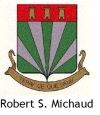 |
Tour of the Canadian Maritimes
In 10 days (Or Less)
Story and photos by Robert Michaud
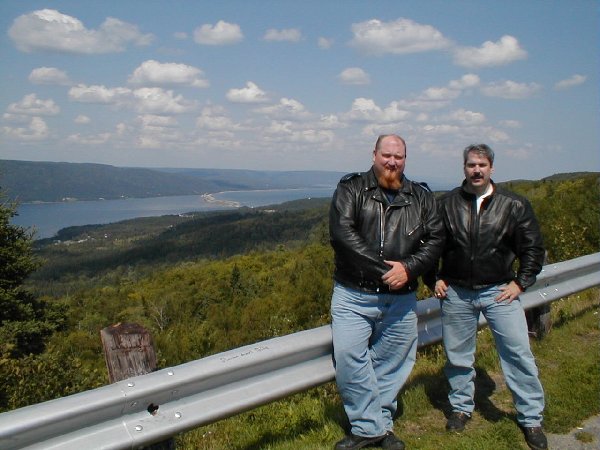
Trips such as this usually begin with some amount of planning and preparation. My riding partner, Tim Flack, and I had been inspired to venture north to Labrador by an article in Rider Magazine ("The Viking Trail" June 1999). The story told of a Viking Settlement (the only confirmed one in North America), scenic vistas, and friendly people. A side note of the story talked about riding in Labrador, and reaching the end of the road. The end of the road - now this was intriguing! A study of maps and travel information for the Province of Labrador and Newfoundland confirmed that there is only a small stretch of road that one could explore by motorcycle in Labrador. From that point on, our primary goal for the trip was to get to 'the end of the road'.
Reaching the end of a road, however remote, does not a trip make. We began to discuss what our vacation time would allow. Tim collected most of the data, and together we surmised that by putting in some long days in the saddle, we could travel to each of the Canadian Maritime provinces in 10 days, weather permitting. The details were a bit sketchy; we did not plan ahead and make reservations for each ferry trip (there would be six in all), but rather chose to let the schedule play itself out as we went. Not everyone is comfortable in traveling this way, but it suited us. We had the flexibility to change our route to accommodate virtually anything that came up. Traveling toward the end of the tourist season also afforded us opportunities that may have not been available earlier in the season. We never had to hunt for lodging or worry about there not being enough room on a ferry.
So, one week before Labor Day weekend, we pointed our bikes east on a Friday morning and set out to see what we could see. We departed from my small town in Central Maine and made our way to the ferry dock in Bar Harbor. From here, we would take The Cat to Yarmouth, Nova Scotia. The Cat is a relatively new ferry that, as the name implies, is a catamaran that can travel at up to 55 knot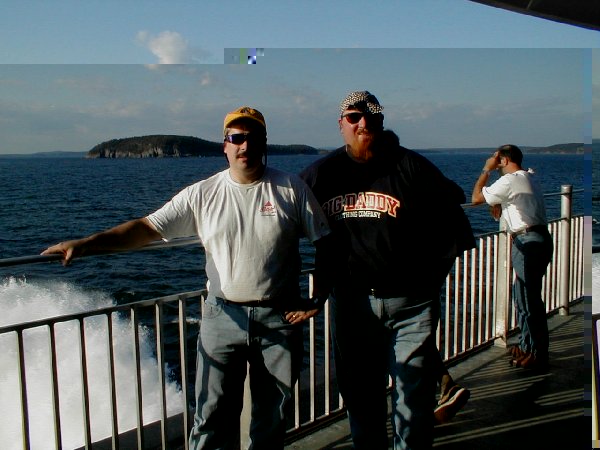 s. Unfortunately, on that day, The Cat was wounded and was running on only three out of her four engines and could only make about 32 knots. She left late from Bar Harbor, and the crossing took 3 1/2 hours instead of the normal 2 1/2. By the time we reached Nova Scotia, it was 9:30 PM. A quick search for lodging in Yarmouth was fruitless. We decided to head up the road to the next town and find lodging there. Miles (or more correctly stated, kilometers) passed and we were no closer to a warm bed than we had been when we started. Worse still was the thick fog that was now rolling in off the ocean. Riding with my face shield up, I could feel the moisture collecting on my face and running down my cheeks. It was a bit cool out, but we were most concerned about running into a woodland creature on the road. Great or small, animals of any size are not welcome when riding with reduced visibility and less reaction time. s. Unfortunately, on that day, The Cat was wounded and was running on only three out of her four engines and could only make about 32 knots. She left late from Bar Harbor, and the crossing took 3 1/2 hours instead of the normal 2 1/2. By the time we reached Nova Scotia, it was 9:30 PM. A quick search for lodging in Yarmouth was fruitless. We decided to head up the road to the next town and find lodging there. Miles (or more correctly stated, kilometers) passed and we were no closer to a warm bed than we had been when we started. Worse still was the thick fog that was now rolling in off the ocean. Riding with my face shield up, I could feel the moisture collecting on my face and running down my cheeks. It was a bit cool out, but we were most concerned about running into a woodland creature on the road. Great or small, animals of any size are not welcome when riding with reduced visibility and less reaction time.
After about an hour, we passed the dimly lit sign for "The Old Schoolhouse - Restaurant, Bar and Hotel". We pulled in, but didn't have high hopes. The parking lot was empty, and the housekeeping cabins seemed full. In desperation, we went to the front door and found it locked. We knocked loudly and were surprised to find someone still inside. He confirmed that they were indeed closed, but he did have one cabin left and would be happy to let us have it.
The next morning bright blue skies and a view of the Atlantic that we could not have seen the night before greeted us as we prepared for our first full day of Canadian riding. After a quick breakfast, we hopped on our bikes and made our way up the south shore of Nova Scotia heading towards Halifax. I am riding a 1986 Yamaha FJ1200, and Tim is on a 1987 Honda Shadow. While not new, our machines have served us well for years, and have been solid, comfortable rides.
The journey up the south shore of Nova Scotia is a treat for the senses. The winding road dips in and out of small fishing villages and through scenic wooded stretches. The contrasting smells of the ocean and evergreens add to the beauty and make a truly memorable ride. The weather could not have been better either, with bright sun and warm temperatures that were offset by cool ocean breezes.
Along the south shore, not far from Halifax, you can stop at the tiny town of Peggy's Cove. Peggy's Cove has always been 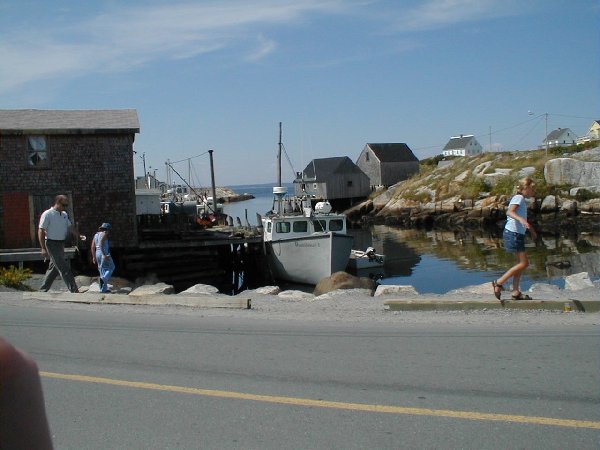
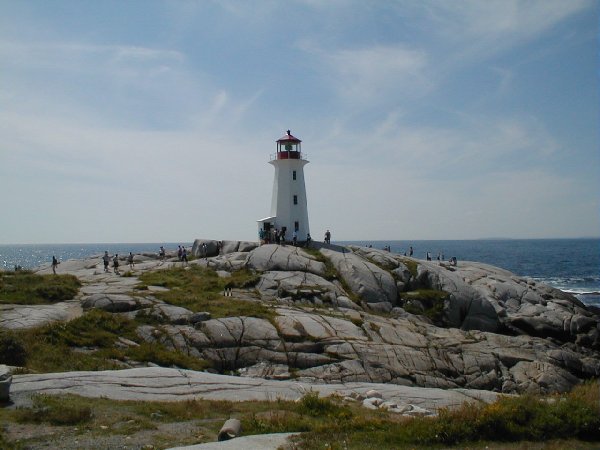
popular with tourists, but it gained even more notice in 1998 with the crash of Swiss Air flight 111. During the rescue effort, the town was inundated with rescue workers, reporters, friends and family of the victims of the crash just of its shore. There is a memorial nearby that stands as a reminder of that crash, and punctuates the beauty of the area with the reality that, even in this idyllic environ, bad things still happen.
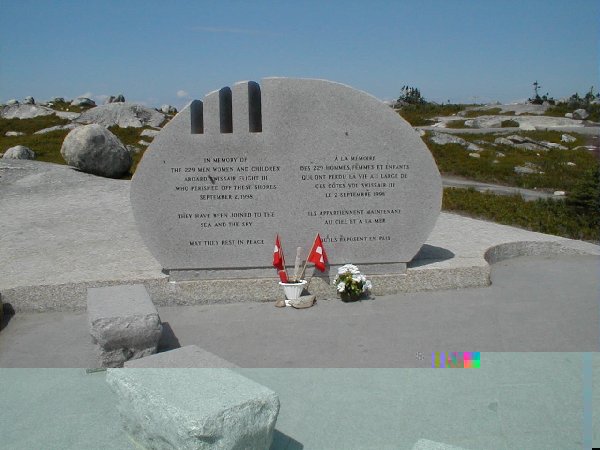
After lunch at a small seafood restaurant on the coast, we passed through Halifax, and instead of heading north on what would have been a more direct route towards our goal, we chose the road less traveled. That is, we chose to stay along the south shore on Route 7, then followed it north to Antigonish. Tim had been there before for the Highland Games, and even met Jean Cretien when he was campaigning for Prime Minister. When we arrived in town, we pulled over on a side street to consult the map and try to determine where we might spend the night. Our only encounter with Canadian law enforcement came when a RCMP constable pulled over alongside us and offered his assistance. We explained that we were just looking for a place to stay and grab a bite to eat. The constable was very polite and courteous, and offered a few options for us. We thanked him, and took one of his suggestions for a motel just outside of town. Later, we remarked that such an encounter in the States would be unlikely, and it was refreshing to have a conversation with police that didn’t end up in a ticket of some kind. 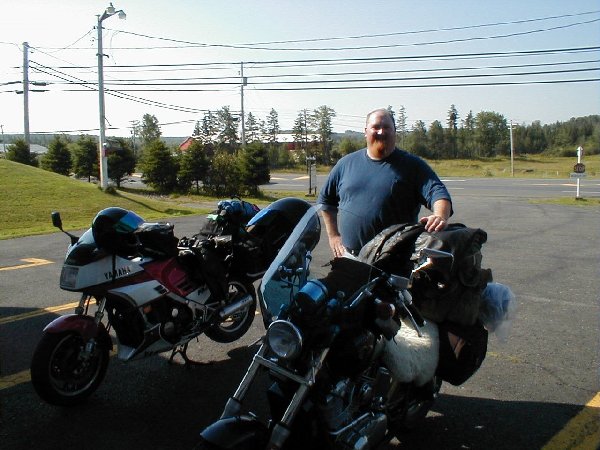
The next morning, we headed toward Cape Breton, an island on the northeastern tip of Nova Scotia. This island is home to the Cabot Trail and other scenic drives. To ride the Cabot Trail takes the better part of a day, and we didn't feel that our schedule permitted it. However, to get to the ferry landing in North Sydney, one must right on part of the Trail, and even this small piece was rewarding. There is much more to see on Cape Breton, including the Highlands National Park, the Alexander Graham Bell National Historical Park, and several provincial parks. They will have to wait for the next trip, as we have our sights set on a much further goal. 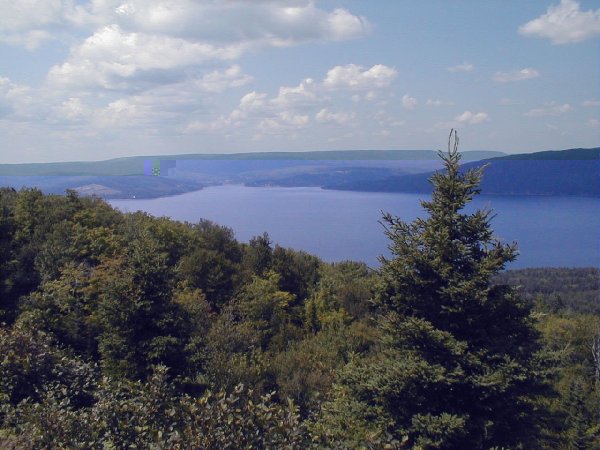
W e ar ri v e d at the ferry landing in the early afternoon, and were happy to learn that the next ferry would be leaving in less than an hour. We boarded the "Smallwood", one of three ferries that travels between North Sydney and Port aux Basques, Newfoundland. The Smallwood is a large ferry, and it travels at a more conventional 22 knots. The crossing to Newfoundland takes somewhere in the neighborhood of five hours. This put us in port around 7:00 PM.
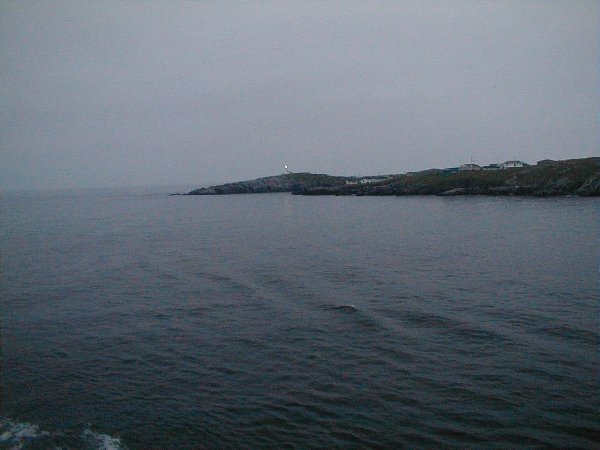
We had been warned on several occasions that it is unwise to attempt to drive (let alone ride) in Newfoundland at night. The province has a high population of moose and caribou, and the collisions with vehicles are common and sometimes disastrous. We found very comfortable lodging at the St. Christopher Hotel in Port aux Basques. You have to drive through town (not a very long ride, mind you) to get there, but the lodging information we found rated this hotel highly, and it was worth the extra few minutes ride. Besides having clean, comfortable accommodations, the staff was very friendly and helpful. We took time to learn about the area that we would be exploring from a lovely bartender by the name of Mary. Her insights and stories made us all the more anxious to continue on our journey.
The next morning we awoke once again to bright sunshine and moderate temperatures. The road north from Port aux Basques wove through miles of forest on its way to Corner Brook and Deer Lake. Corner Brook is a paper mill town that seems large compared to its surroundings, but has a distinct mill town feel to it. From Corner Brook to Deer Lake, there is a brief stretch of four lane divided highway. Now, no one has ever accused Tim and I of driving too slow, but on this stretch of road I had to wonder if our speedometers were working properly when we were passed by a hearse at 85 mph! Indeed, throughout the province, I couldn't help thinking we were taking liberties with the posted speed limits, only to find locals bearing down on us from behind.
Leaving Deer Lake, we entered Gros Morne National Park as we traveled northward. This was one of the areas we had heard the most about, and for good reason. The winding road through the mountains rivals many other rides along the East Coast. The scenery was so breathtaking that on a number of occasions I had to remind myself that I had a job to do -- namely to pay attention to where I was going, lest I become a bit too intimate with the spectacular forest I was admiring. Every bend in the road gave way to an even more picturesque view of the mountains, lakes, forest and ocean that make up this vast and diverse park. Wildlife abounds here, and they command both your attention and your respect. They are beautiful to look at, but a cyclist needs to be watchful that they are not trying to occupy the same patch of road that you are.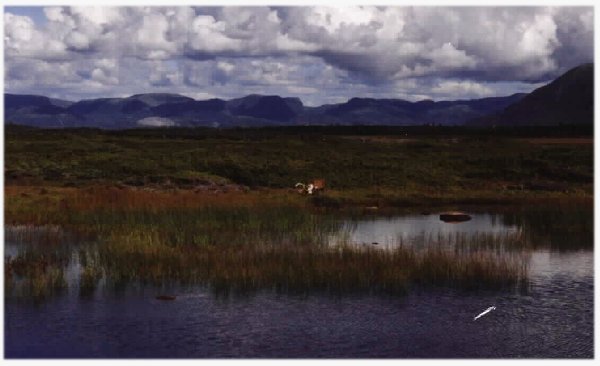 I spied a large caribou foraging 50 yards from the road and quickly pulled over to get a better look. At first I was fearful that I would scare him away before I could snap a picture, but I soon realized that I would have to do a lot more than rustle my tank bag to get his attention. Before I left, I had snapped off two pictures and even honked my horn to get Tim's attention and the caribou could not have cared less. Magnificent! I spied a large caribou foraging 50 yards from the road and quickly pulled over to get a better look. At first I was fearful that I would scare him away before I could snap a picture, but I soon realized that I would have to do a lot more than rustle my tank bag to get his attention. Before I left, I had snapped off two pictures and even honked my horn to get Tim's attention and the caribou could not have cared less. Magnificent!
Another prominent feature of the park was the mountains, or more correctly, plateaus known as the Tablelands. At over 2000 feet, they are not overly tall, but their flat top appearance stretches for miles and miles. In between some of the mountains you can find some fantastic gorges with walls reaching to near the top 2000 feet up
. 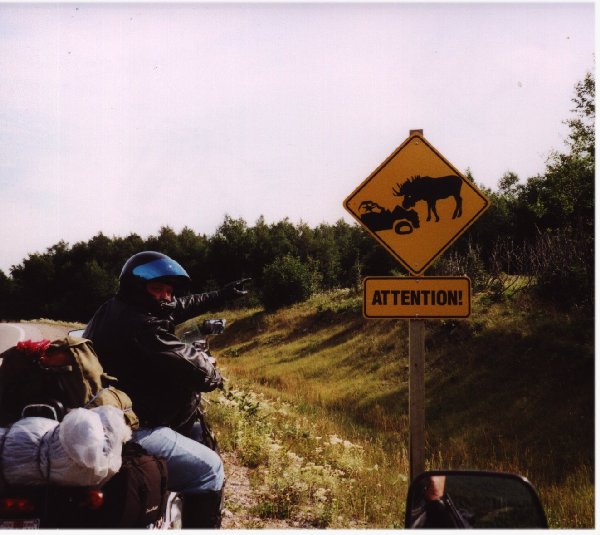
Continuing north from Gros Morne, we followed the western coast of the Northern Peninsula of Newfoundland. This is much less a matter of choice than necessity, as it is really the only road to the northern tip of the peninsula where we will take a ferry to Labrador. It is in this area of the province that it started to sink in that we are truly in a remote area. Reflecting back on the preventive maintenance and thoughtful packing for the trip all of a sudden seems a much more valuable use of our time than it did when we performed those mundane tasks. Motorcycles are not rare up here, but they are certainly not indigenous either. We have passed a few other intrepid riders, and have even met up with some from time to time, but you won't see many parked in the yards of residents.
Instead, there are regular reminders of the primary industry in the area - fishing. Small villages dot the shoreline up the coast, but they are not the quaint, picturesque villages of Nova Scotia. These are much more stark, lonely looking, and hard. We later learned that for much of the year, local fisherman must find other sources of income, or rely on unemployment insurance. The neat stacks of hundreds of lobster traps on the side of the road and along the shore were a silent testament to difficulty in providing a living here.
By evening, we had made it to St. Barbe. Our timing was impeccable, as a rain shower caught us just as we were pulling into town. The last ferry to Labrador had left hours earlier, but the motel next door to the ticket office had vacancies and a restaurant, so we settled in for the night.
We rose early to purchase our ticket to board the ferry "Apollo", and rode aboard. Apollo appeared to be a ship out of time, decorated in 60's style, but well maintained and still making the rounds up and down the coast of Labrador and over to Newfoundland. 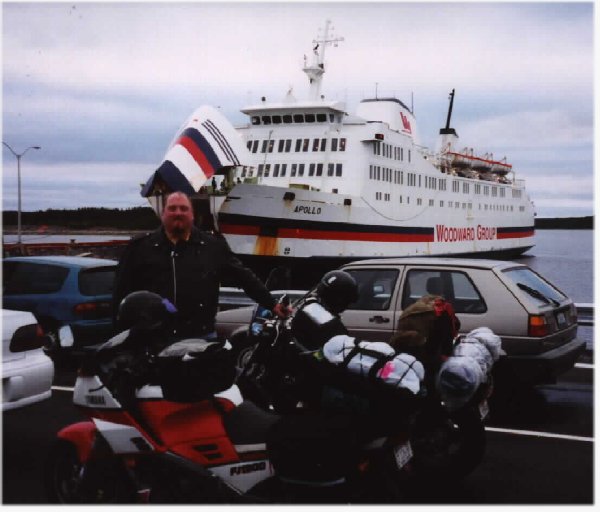 The brief 1 1/2 hour ride across the Strait of Belle Isle brought us into Blanc Sablon Quebec by 9:30 AM or so. Now if you remember the title to this piece, it describes this trip as a ride to the Canadian Maritimes, implying that we rode through each of the Maritime Provinces in our journey. This is, in fact, the truth, but the only part of Quebec that we enjoyed was this one small town of Blanc Sablon. The brief 1 1/2 hour ride across the Strait of Belle Isle brought us into Blanc Sablon Quebec by 9:30 AM or so. Now if you remember the title to this piece, it describes this trip as a ride to the Canadian Maritimes, implying that we rode through each of the Maritime Provinces in our journey. This is, in fact, the truth, but the only part of Quebec that we enjoyed was this one small town of Blanc Sablon.
Travelling into Labrador via motorcycle does not offer many miles of road either, but all of it was worth it. From Blanc Sablon to Red Bay (the furthest point you can ride to on a road bike) is only 54 miles or so, but it is road like no other. The geography and geology of the area are so strange compared to what we were used to in the Northeast United States, and yet it was so easy to visualize how the glaciers had formed and reformed this land for countless millennia. Huge boulders lay scattered about like a child's forgotten toys.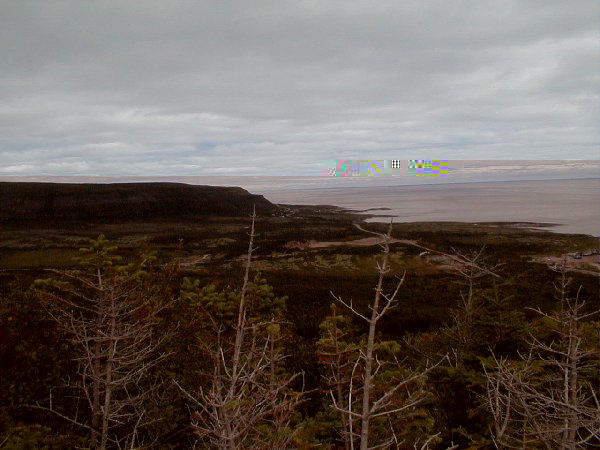 The exposed rock shows off its scars of the age s. Tre es struggle for life in this harsh environment, and the struggle leaves them knarled and twisted. You won't find any deciduous trees here, only evergreens, and even they struggle to reach taller than 5 or 6 feet. There are plenty of low fruit bearing bushes around, and some of them produce local favorites such as Partridge Berries (lingon berries), and Bakeapple or Cloudberries. The former tastes like a cranberry without the bitter edge, and the latter tastes (as the name implies) like baked apples, but it has the shape and consistency of a raspberry. This place has a unique beauty all its own, and it is best observed while exposed to its elements - breathing in its pure air, feeling the biting breeze off the North Atlantic, and tasting the wild berries that we have never heard of before. The exposed rock shows off its scars of the age s. Tre es struggle for life in this harsh environment, and the struggle leaves them knarled and twisted. You won't find any deciduous trees here, only evergreens, and even they struggle to reach taller than 5 or 6 feet. There are plenty of low fruit bearing bushes around, and some of them produce local favorites such as Partridge Berries (lingon berries), and Bakeapple or Cloudberries. The former tastes like a cranberry without the bitter edge, and the latter tastes (as the name implies) like baked apples, but it has the shape and consistency of a raspberry. This place has a unique beauty all its own, and it is best observed while exposed to its elements - breathing in its pure air, feeling the biting breeze off the North Atlantic, and tasting the wild berries that we have never heard of before.
In Red Bay, we found the end of the road that we had been searching for. There were a couple of short dirt roads that led off to private residences, but at the end of the paved road was a small restaurant and gift shop. We ate, bought gifts and chatted with the shopkeeper about the summer and what it was like to live in this seemingly remote place. She explained that she had grown up in a small village even further north that had no roads leading in or out of it. The primary modes of transportation were airplanes and snowmobiles. Tim and I have both grown up in small towns, but to us, home seemed like a metropolis compared to this lifestyle. 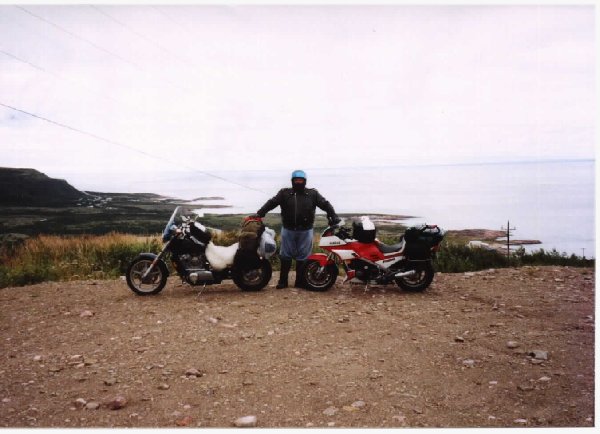
Soon it was time to head back. In planning ahead for our trip, we allowed some buffer time in case if inclement weather, mechanical or health problems. However, while we were technically ahead of schedule, we felt it prudent to grab the afternoon ferry back to Newfoundland. We got back to Blanc Sablon at about the same time as the ferry arrived. A couple of the passengers aboard were also motorcyclist, but they had left their bikes back in Newfoundland. They didn't think it would be worth the time and expense to bring them over to Labrador. We chatted for a little and told them of the short, but rewarding ride to Red Bay. We boarded the Apollo and bid farewell to our comrades in wheels. After strapping the bikes down to the car deck, Tim and I went up to the stern observation deck to watch our departure. To our surprise, we saw the two bikers we had just met, running back to the boat. We met them again when they got to the deck that we were on, and they told us that they were considering going back for their bikes. As it turns out, they decided that they couldn't spare the time, and never did return with their bikes. We caught up with them on a few more occasions on our journey back through Newfoundland, and even shared the same ferry with them back to Nova Scotia.
When we arrived back in Newfoundland that afternoon, we decided that since the weather appeared to be holding out and we were ahead of schedule, we should investigate the Viking ruins in L'Anse aux Meadows. It was about 125 kilometers out of our way, but it was also the most notable attraction in this area.
We stopped for the night in a small town just outside of L'Anse aux Meadows. We stopped for our last fuel up of the day at the local Esso station. There we met a very friendly and helpful shopkeeper who was very interested in our journey. We inquired about the best places for food and lodging in the area, and she obliged. We stayed that night in a brand new motel. So new, in fact that the water from the well had not settled out yet, and we were given bottled water to drink from. The accommodations were very comfortable, but while they had television, there was no cable. Consequently, the only station to choose from was CBC North. This in and of itself was not that surprising, but we did learn that in this area of Canada, they offered two languages in their official broadcasts - English and Cree. The Cree are the dominant native tribe of the area, and the use their language has its own alphabet. Quite different from the English and French we have been used to in the lower Canadian provinces.
Before packing it in for the night, I was performing my daily maintenance ritual that included cleaning and lubricating my chain and checking the battery fluid level. During the latter operation, I made the amateur mistake of over-tightening one of the cell caps, and broke the top off. About the time that this happened, our friendly shopkeeper from the Esso station was driving by and saw me working on the bike. She decided to stop and see if there was anything wrong. I told her about my dough-head mistake, and she said that I should stop back by in the morning. Her husband would be working then, and he might have a replacement for me. The next morning, I came up with a pretty good roadside solution to the problem and almost didn't take her up on her suggestion. At the last second, I ducked into the station. Sure enough, her husband had waited for me, and had found an exact replacement for the battery cap that I had broken. This was surprising at first because of the total lack of motorcycles in this area. What they lack in motorcycles, however, they make up for in snowmobiles and ATV's, and the batteries are similar if not identical. The husband was as kind as his wife, and would not accept payment for the cap. I thanked him and we were on our way to the Viking settlement.
Historians have suspected for quite some time that the Vikings actually pre-dated the discovery of the North America by Columbus, but it wasn't until the 1960's when the settlement at L'Anse aux Meadows (Meadow Cove in French) was discovered that their suspicions were confirmed. The site is relatively small, and archaeologists believe that it was a way-station of sorts. From the evidence there and from the stories told in the Viking Sagas, it is thought that Leif Erikson may have past through this area in his quest for a new Greenland. Leif's father, Erik the Red, had fled to Greenland in exile from Iceland, and while Erik named his new home Greenland, life was difficult there. It is believed that Erik the Red actually named the new land "Greenland" to make it sound more appealing to his followers. In like manner, the maps created by Lief Erikson in his exploration of the New World describe a place called Vinland or "Vine Land". Descriptions of this beautiful new land talk of fertile soil and wild grape vines everywhere. Whether this was a lie to entice others to settle there, or there another place as yet undiscovered that is the true Vinland is still a subject for debate. The maps created by Lief, however, bear a striking resemblance to that of the Northern Peninsula of Newfoundland, and most scholars conclude that this is the Vinland described by Lief, even though grapes have never been indigenous to the area.
What is left in L'Anse aux Meadows is the remains of the group of sod huts that the Viking settlers used.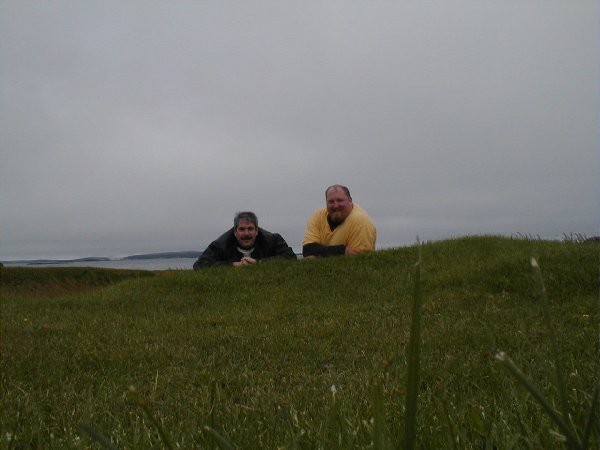 Archaealogical excavations have revealed some interesting information about the lifestyle of these settlers and what they did (and did not) leave behind. Most notably, they did not leave any bodies behind. It is assumed that if there were any deaths in the settlers, that they took their bodies back to Greenland for burial. The Vikings were only there for a few years, but in that time, they set up a 'smithy' to smith iron. The raw materials, bog iron, were relatively plentiful, but of low quality. During the time of their settlement it is estimated that they only produced about 5 pounds of iron. Archaealogical excavations have revealed some interesting information about the lifestyle of these settlers and what they did (and did not) leave behind. Most notably, they did not leave any bodies behind. It is assumed that if there were any deaths in the settlers, that they took their bodies back to Greenland for burial. The Vikings were only there for a few years, but in that time, they set up a 'smithy' to smith iron. The raw materials, bog iron, were relatively plentiful, but of low quality. During the time of their settlement it is estimated that they only produced about 5 pounds of iron.
Vikings were traders, as well as raiders, and in fact preferred to trade in most instances. Typically, when meeting new people, Vikings would try to establish trade relations first, but if they didn't get what they wanted, they would return at night and take what they wanted. Their barbarous reputation is a result of their tenacity and inability to take 'No' for an answer. This policy appears to have got them in trouble in the New World, though, where their warring technology was no match for the numbers of natives that they faced. After a few short years they retreated to Greenland, never to return.
I couldn't help but feel that we, in some strange way, had something in common with these ancient explorers. What is it that draws men to travel and explore? We do not need to chart unknown territory, or flee any fearsome foe, and yet we are drawn to the unknown for the sake of the journey. Our exploration of the Canadian Maritimes is an exercise of indulging in the journey, and we have found that the motorcycle enhances that indulgence over most other forms of transport. The exposure to the weather, the scent of the salty air or evergreens, and the rush of the wind all combine to engage the senses in a way that is nearly narcotic in its addiction. Imagining how the Vikings must have traveled in their longships must have been similarly as exciting, and for these reasons, I feel a sort of kinship with those primitive travelers.
We left L'Anse aux Meadows with one goal in mind - to get as close to Port aux Basques as possible so as to be able to catch the early ferry back to Nova Scotia in the morning. We didn't leave L'Anse aux Meadows until around 11:00 AM, though, and so our nearly 500 mile journey southward looked daunting. The weather that morning was overcast and cold. It had warmed up into the 50°'s by mid morning, but it had started in the 40°'s early in the day. We dressed accordingly, but by the time we reached Corner Brook in the middle of the province, the temperature was in the 70°'s. 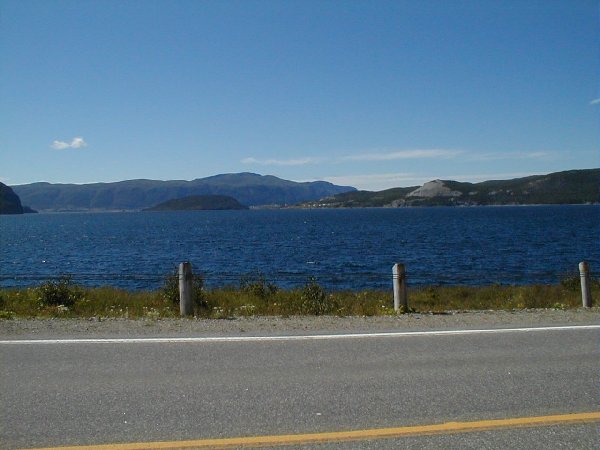 We enjoyed sunny, warm weather through Gros Morne on our return trip. The weather that had warmed up in our favor, however, was not to last. By mid-afternoon, it began to get cool again, and the skies became more and more overcast. We kept the heat on, trying to make it to Port aux Basques before sundown and any rain. We failed on both counts. With only 50 kilometers left to go, the sprinkles that had come and gone in the past hour decided to stay on and turn into more serious rain. Rain is no stranger to any motorcyclist that has done much touring, but we were especially displeased to see it come this day. Between our destination and us was a fairly substantial construction site that would turn to soup in this weather. There was also the threat of meeting some of the great wildlife of this province on the road. While we enjoyed their majesty and spectacle in the beauty of Gros Morne National Park, their presence on the road in the evening with the reduced visibility caused by the rain was not welcome. Fortunately, we did make it without incident, and once again we stayed at the St. Christopher Hotel. We were having dinner in the dining room when one of the two riders we had met in Labrador wandered in. We asked about his travelling companion, and he said that they had gotten separated and wasn't sure where he was. They wouldn't see each other until the next morning on the ferry, even though they both stayed in the same hotel. Long hours in the saddle and bad weather can play tricks on the mind, it seems, for they didn't even see each others bikes in the parking lot. We enjoyed sunny, warm weather through Gros Morne on our return trip. The weather that had warmed up in our favor, however, was not to last. By mid-afternoon, it began to get cool again, and the skies became more and more overcast. We kept the heat on, trying to make it to Port aux Basques before sundown and any rain. We failed on both counts. With only 50 kilometers left to go, the sprinkles that had come and gone in the past hour decided to stay on and turn into more serious rain. Rain is no stranger to any motorcyclist that has done much touring, but we were especially displeased to see it come this day. Between our destination and us was a fairly substantial construction site that would turn to soup in this weather. There was also the threat of meeting some of the great wildlife of this province on the road. While we enjoyed their majesty and spectacle in the beauty of Gros Morne National Park, their presence on the road in the evening with the reduced visibility caused by the rain was not welcome. Fortunately, we did make it without incident, and once again we stayed at the St. Christopher Hotel. We were having dinner in the dining room when one of the two riders we had met in Labrador wandered in. We asked about his travelling companion, and he said that they had gotten separated and wasn't sure where he was. They wouldn't see each other until the next morning on the ferry, even though they both stayed in the same hotel. Long hours in the saddle and bad weather can play tricks on the mind, it seems, for they didn't even see each others bikes in the parking lot.
The next morning we were treated to another ride on a catermaran ferry. This time it was aboard the "Max Mols", better known to locals as the "Vomit Comet". It is of the same design and vintage as The Cat that sails from Bar Harbor, Maine to Yarmouth, Nova Scotia, but from the stories we heard, it suffers from more severe seas between Nova Scotia and Newfoundand. Because it rides on the surface of the water and drafts very little, it is much more subject to rough seas than a traditional ferry. Consequently, it has had its share of seasick passengers, and even damage to vehicles on the car decks that shift during transport. Or crossing was very smooth, however, and we appreciated the reduced travel time. This ride took less than three hours, as compared to a five-hour trip to Newfoundland. In addition, we were treated to whales spouting off in the distance while we enjoyed a buffet breakfast. Tim and I are both engineers, and the propulsion system, sleek design and sheer speed of these boats fascinated us. They were a treat to ride for those experiences alone, and the fact that the trip aboard the Max Mols cost the same as the other ferries ($51 CDN for motorcycle and rider), it was a relative bargain.
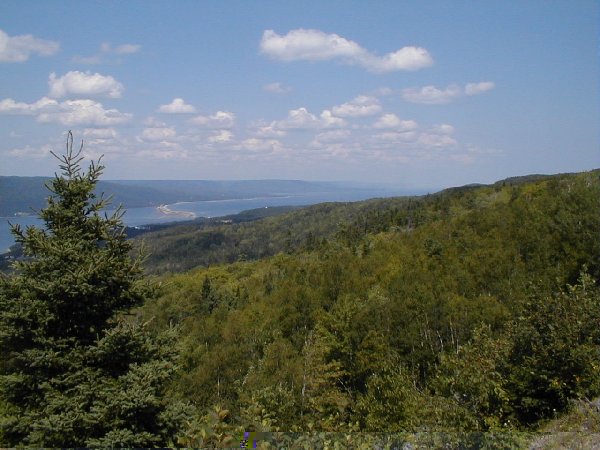
We arrived back in North Sydney in the mid-morning, affording us the opportunity to put some miles behind us before lunch, something we would not have been able to do if we had come back aboard the Smallwood or Caribou - more traditional ferries. In fact, by just after noon, we had made it to the ferry landing to Prince Edward Island. This would be our second day of dual ferry rides. This was a much shorter crossing, taking only an hour and a half to complete. It was so short, and the waters so calm, that they don't require you to lash your motorcycle to the deck. This was very strange, and we almost insisted upon using tie-downs anyway, but some local riders convinced us that the trip was, indeed, going to be smooth. With the exception of a very rude deck hand, the short journey was a pleasant one. One further note, if you are planning to tour Prince Edward Island (PEI), it is wisest to take the ferry over, and the Confederation Bridge on the return trip. They don't charge visitors for coming onto the island, only for leaving, and leaving via the bridge is the least expensive ($14.95 CDN for a motorcycle and rider).
Prince Edward Island is a beautiful, almost magical island, with tidy small farms, rolling hills and quaint villages.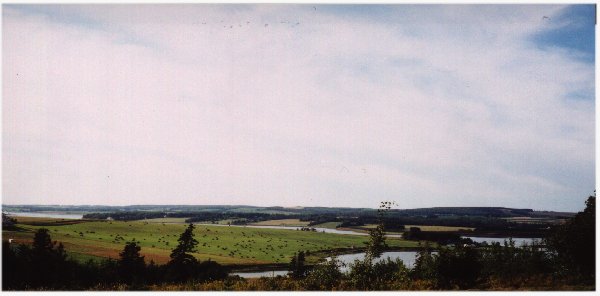 It feels very much like you are taking a step back in time. This island is the home of the Anne of Green Gables series by L.M. Montgomery, a local author of the late 19th and early 20th century. She wrote stories from a young girl's perspective about life growing up on the island. My wife is fond of these stories, and I knew she would appreciate it if I were to bring something back for her from the site of the house that was the focus of Anne's childhood. We got there at 4:30 in the afternoon and asked for tickets to get in ($5 CDN). The attendant was happy to oblige, but noted that "the park closes in 1/2 hour", to which I replied - "That will be plenty of time"! I don't mean this as a put down to Ms. Montgomery's work, and I have even watched the television show spin off from the series, "Avonlea" with my wife on occasion, but this was not really OUR kind of attraction. In fact, I am sure that the site of to large, leather clad men walking through this picturesque period village caused reactions ranging from shock to fear among the other patrons. It feels very much like you are taking a step back in time. This island is the home of the Anne of Green Gables series by L.M. Montgomery, a local author of the late 19th and early 20th century. She wrote stories from a young girl's perspective about life growing up on the island. My wife is fond of these stories, and I knew she would appreciate it if I were to bring something back for her from the site of the house that was the focus of Anne's childhood. We got there at 4:30 in the afternoon and asked for tickets to get in ($5 CDN). The attendant was happy to oblige, but noted that "the park closes in 1/2 hour", to which I replied - "That will be plenty of time"! I don't mean this as a put down to Ms. Montgomery's work, and I have even watched the television show spin off from the series, "Avonlea" with my wife on occasion, but this was not really OUR kind of attraction. In fact, I am sure that the site of to large, leather clad men walking through this picturesque period village caused reactions ranging from shock to fear among the other patrons. 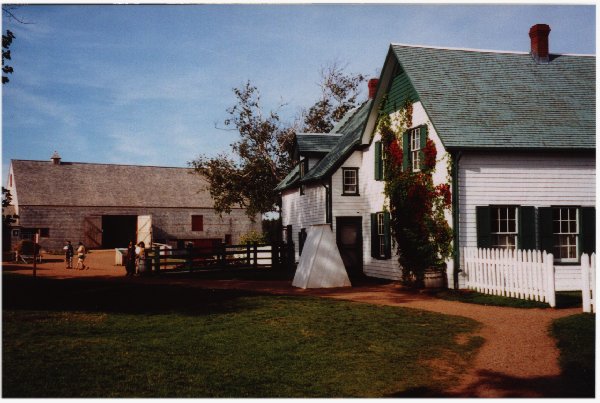 We made our way through quickly, and did manage to enjoy the park with the time that we had. After grabbing a few souvenirs for those who await us at home, we were off to find lodging once again. We made our way through quickly, and did manage to enjoy the park with the time that we had. After grabbing a few souvenirs for those who await us at home, we were off to find lodging once again.
We spent that evening in a small town called Sunnyside, not far from the Confederation Bridge. We stayed in a small, family motel that was build in the late 50's or early 60's and looked to be almost perfectly preserved from that time period. It amazed me how clean and well maintained it was, knowing full well that the fixtures and appliances in the room had to be older than I am! The only downside was the somewhat overzealous employee, but we figured he was just doing his job.
The last day of our trip took us from Prince Edward Island, all the way back to my home in Maine. It was a distance of over 500 miles, but we were excited to get back and share some of the stories from the trip. The day started off warm and a bit windy, but before too long, it began to get very hot. In fact, it turned out to be the hottest day of the summer. Several construction areas slowed the ride across the Confederation Bridge, 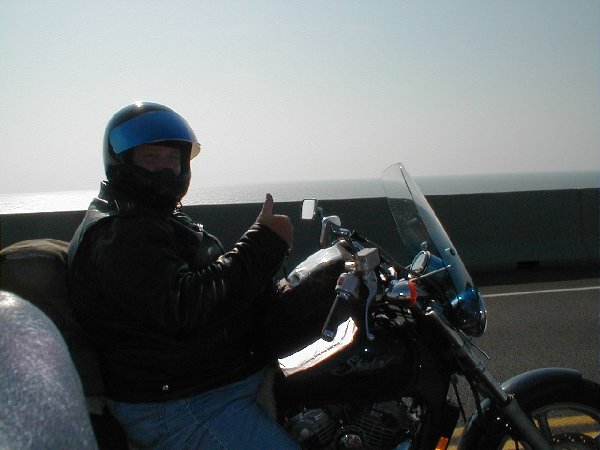 one of the longest in North America. Once into New Brunswick, the temperature began to rise. Riding faster didn't help much, but didn't hurt either. We had one brief reprieve when riding through St. John, a city right on the coast where we were able to enjoy a freshening breeze from the Atlantic. Heading inland again and crossing over into Maine, the temperature only climbed higher. one of the longest in North America. Once into New Brunswick, the temperature began to rise. Riding faster didn't help much, but didn't hurt either. We had one brief reprieve when riding through St. John, a city right on the coast where we were able to enjoy a freshening breeze from the Atlantic. Heading inland again and crossing over into Maine, the temperature only climbed higher.
Our last rest stop would come in Brewer, Maine, just across the Penobscot River from Bangor. From here, we had just 100 miles left to go, most of them being highway miles. We arrived to find an invitation to join my wife, son, and in-laws for dinner at a local restaurant for supper - ah, what's a few more miles…
In recounting our journey through the Canadian Maritimes, I am continually reminded of the sights, sounds, smells and tastes from our journey. We completed our trip in a short 8 days from the start, due in part to favorable weather, hitting the ferries at just the right times, and the absence of any problems (mechanical or otherwise). However, it is not the time that we took or didn't take (compared to our plan) to complete the journey, but the ride itself that is the savory flavor of the memories. Many people wouldn't think of covering nearly 3000 miles in just over a week. Some could do it faster. Regardless of the time taken, it is the ride that makes the trip.
|
